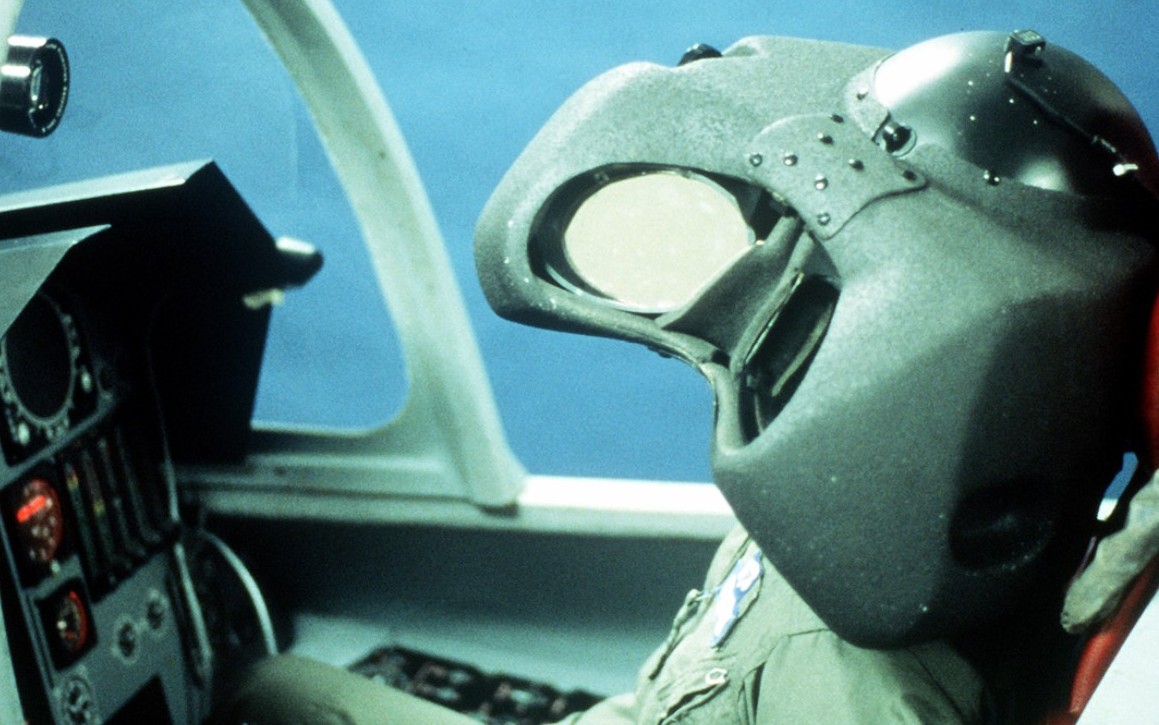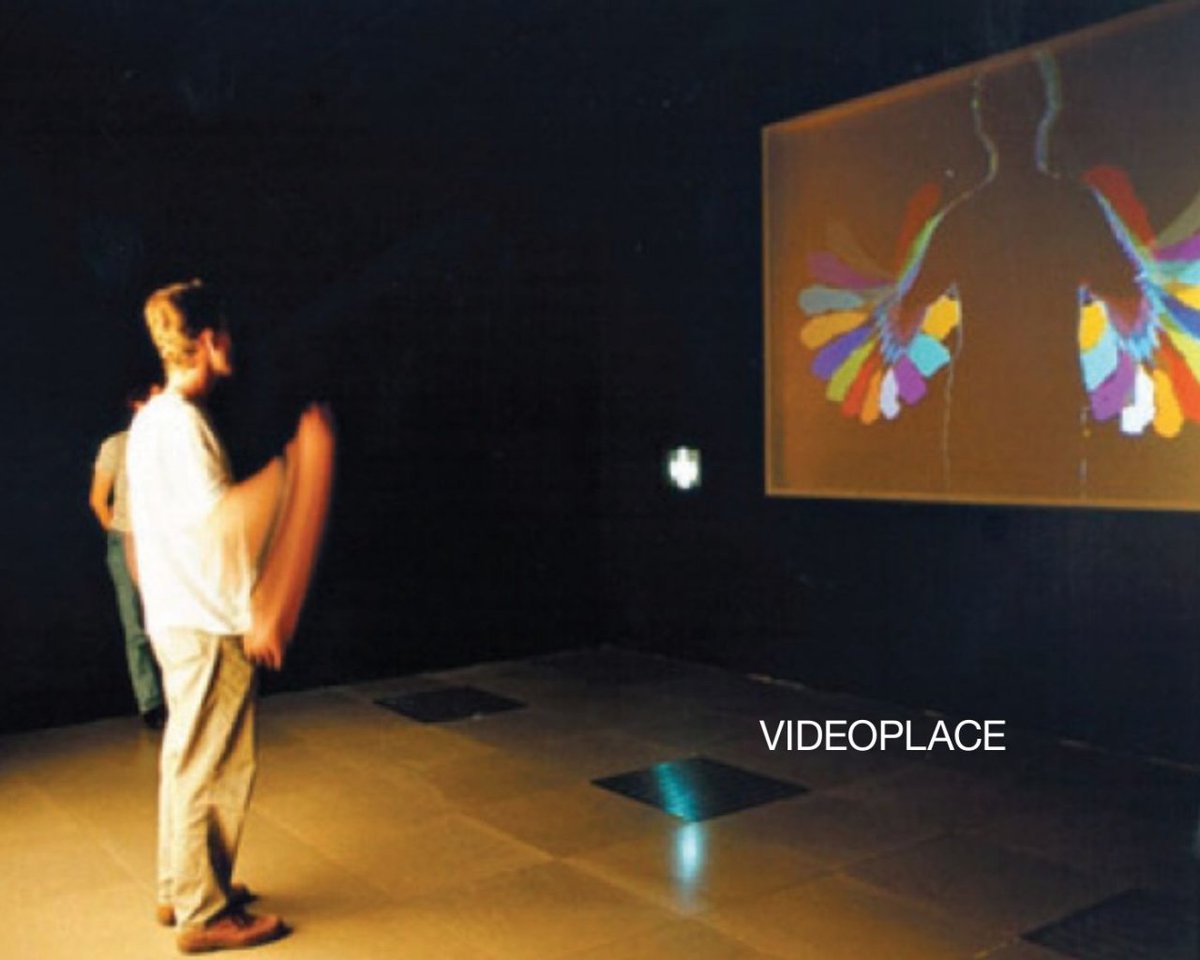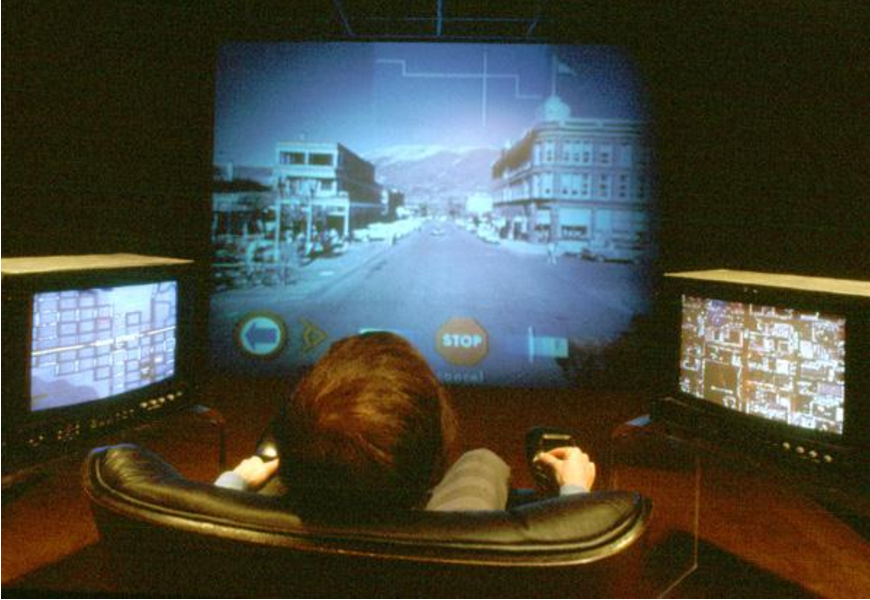
1970s - military development, interactive maps and art experiments
So, perhaps the first notable development of the 70s was a flight simulator for military aviation pilots with a full-fledged flight simulation from General Electric. Development began in the early 60s, but with the improvement in the quality of transistors, as well as with the development of transistor circuitry and computer science, it was possible to create a full-fledged computer flight simulation. A characteristic feature was a 180-degree view, due to the use of 3 screens that surrounded the cockpit. Flight simulators using this principle are still in use today.
The next step in the development of virtual reality technologies is Kruger's VIDEOPLACE. The complex is the first interactive VR platform. The system was first shown at the Milwaukee Arts Center in 1975. VIDEOPLACE used computer graphics, projectors, video cameras from one of the earliest tracking systems for object location. The system, like the military simulators of the time, did not use glasses or gloves.

The platform was based on a dark room with large screens that surrounded the user. Like modern kinect systems, the user's movements were transmitted to computer models. Also, the models of users in different rooms could interact with each other in a virtual space, which was a fundamentally new function for systems of this kind.

Another, ideological and conceptual rather than technological breakthrough was the film map of Aspen, Colorado, created by a team of researchers from Massachusetts Institute of Technology.

The system, introduced in 1977, allowed for a virtual tour of the city, much like Google Street View does.
It looked like this:
The content was created by repeatedly photographing the city with a car driving through the streets. During the virtual tour, the footage was interactively reproduced during a virtual visit to the city. A helmet was not used for this, standard CRT and projection TVs were used. The conceptual breakthrough was that VR technologies can simulate other places with sufficient accuracy.
In 1979, the first VR headset appeared, close to modern functionality. We are talking about a small-scale model of the VITAL military aviation simulator from McDonnell-Douglas Corporation. It was equipped with a head tracking system, as well as the pilot's eye movements and computer generated images in stereoscopic video glasses. The helmet was equipped with CRT displays for each eye, and was also equipped with stereo headphones and a microphone for communication with the dispatcher.

1980s - the development of technology and the beginning of mass VR
Many VR stories begin their 80s storytelling with game consoles, forgetting fundamental technological and design breakthroughs. So? in 1982, Sandin and Defanti finalize Sayre gloves that can control hand movements using photocells and light sources. At the moment of movement, the amount of light falling on the surface of the photocell changed, changes in the form of electrical signals were recorded by the system. Some authors write about this as the first experiments in gesture recognition.

In 1985, a company appears that has left a noticeable mark on the development of VR - VPL Research, founded by Jaron Lanier and Thomas Zimmerman. VPL Research is known as the first company to start mass production and sale of virtual reality helmets and gloves. In the 80s, they developed systems such as DataGlove, EyePhone HMD, and Audio Sphere.
All these devices were associated with the gaming industry and did not represent anything fundamentally new, but they were technologically advanced enough for mass production, and also quite easy to use.

The EyePhone is believed to be the first head-tracking gaming device, and The Data Glove was the basis for Nintendo's legendary Power Glove.
In the 1980s, one of the VR pioneers, American researcher Thomas Furness, created a virtual simulator for the Air Force, which was called the Visually Connected Airborne Systems Simulator (VCASS). At the moment, there is not a lot of data about the invention, but it is known that the model imitated air combat and surpassed the analogs that existed at that time in the degree of realism.

From 1986 to 1989, Furness developed another flight simulator known as the Super Cockpit. The training cabin of the simulator was equipped with computer 3D maps, the pilot can see and hear in real time. The helmet's tracking system and sensors allowed the pilot to control the aircraft with gestures, speech and eye movements.
In 1987, the SegaScope 3-D Glasses appeared (1987), in this regard, many call Sega the pioneers of VR in the gaming industry, which is not entirely true. The fact is that the SegaScope 3-D, invented by Mark Cerny, the author of the game Marble Madness, became an accessory for the Sega Master System. The glasses created the illusion of 3D graphics in games, which made a big impression on players in an era when 3D was rare.

At the same time, the SegaScope 3-D was not a VR device in the full sense, since it did not create an imitation of the user's presence in the virtual space, did not track his movements and was limited to creating volumetric images. Regardless, the success of games like Maze Hunter, Missile Defense, and Zaxxon 3D have fueled interest in virtual reality.

The original principle of the glasses is also interesting. CRT TVs, to which the console was connected, were sent to the glasses one by one half the image, so 3D was simulated. There was also a negative effect, due to this principle, the frame rate was halved and flicker noticeable to the eye appeared.
In 1989 Scott Foster formed Crystal River Engineering Inc, which took an active part in the NASA project. The national agency used virtual reality, well-known at that time. Among the innovations was the use of a full-fledged suit, as well as a promising, in terms of degree of realism, audio system. A feature of the latter was the use of binaural effects instead of banal stereo, it was this system that Foster's company was engaged in.

Crystal River was able to create a processing system that allowed the creation of dynamically moving apparent (phantom) sound sources while still working in real time. Binaural sound effects have become one of the technologies that have taken modern VR to a completely new level of realism.
To understand how binaural effects work, just listen to these recordings with headphones:
To be continued
Research of the 70s - 80s created the basis for the mass use, commercial use of MK. The potential of some developments of this time is still being used today, for example, binaural sound, interactive interaction and tracking of body position.
Jeans:
In our catalog you can buy a wide variety of electronics: TVs, speakers, headphones, soundbars and much more. Perhaps in the near future, we will have VR glasses. While we are studying the demand for these devices.